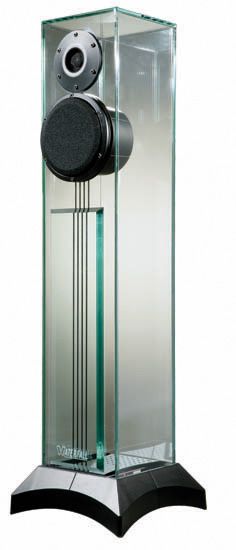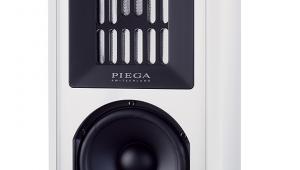Waterfall Audio Iguascu Evo (£2295)
 Peceived wisdom generally has it that a loudspeaker’s enclosure should be inert, so that we hear the acoustic output of the speaker’s transducers unsullied by the additional singing along of a cabinet.
Peceived wisdom generally has it that a loudspeaker’s enclosure should be inert, so that we hear the acoustic output of the speaker’s transducers unsullied by the additional singing along of a cabinet.
As ever in our wonderful world of sound reproduction there are designers who refute this given ideal. The late American speaker maestro Peter Snell, for example, whose Snell Type J and Type E models from the 1970s live on in the guise of today’s UK-made Audio Note speakers. He considered the sound of the wooden enclosure an integral part of the overall design. Chosen thicknesses of wood and – importantly – the size and shape of the box were considered carefully to place resonances in frequency bands where they would ‘augment and support the drivers in their task, not unlike the box of a guitar’ (to quote from Audio Note’s marketing blurb).
But among traditionalists the goal has been to make a cabinet as rigid as possible by employing elaborate internal bracing matrices (tie-bolts, even) and experimenting with all manner of materials to create stiff, inert enclosures. The Townshend speakers that grace my listening room are an extreme case in point: their cabinets comprise a steel box lined with a couple of inches of Plaster of Paris and several rolls of wadding. ‘Dead’ the cabinets unquestionably are. They’re a dead weight, too. Visually unobtrusive and aesthetically pleasing, er, they most certainly are not!
VANISHING FROM SIGHT
So you’d like to make a loudspeaker that looks both out-of the-ordinary and appealing to the house proud – a loudspeaker that will sit harmoniously in the most stylish of living rooms? A cabinet made of see-through glass would look pretty cool, and might seem to ‘disappear’. But you surely wouldn’t make a speaker cabinet out of glass, now would you? That would be downright bonkers…
Yet this is precisely what French company Waterfall Audio chose as its ‘unique selling point’ when setting up in business some 15 years ago: making visually arresting loudspeakers out of glass. And it’s not as dumb an idea as it might first appear, a few other loudspeaker manufacturers subsequently following in Waterfall’s footsteps. Truth is, while glass is highly reflective it is denser than wood and less prone to resonate. The trouble is that working with glass – cutting, polishing and glueing to precise standards – is hardly in the scope of garden shed DIY-ers.
DAMPING SOLUTION
Waterfall works in partnership with glass fabricator Miroiterie Merle [for more, see www.miroiterie-merle.com], having invested in excess of €1.5m in custom-designed machinery to perfect the fabrication of its speakers’ panels and achieve reasonable economies of scale. Waterfall’s proprietor and chief designer Cedric Aubriot similarly works in partnership with designer Thierry Comte’s Welcohm Technology, a French company that makes both drive units and complete speakers under the Atohm brand name.
This Iguasçu Evo, the smallest of Waterfall’s floorstanders, is a two-way employing custom-designed Atohm drivers that feature vented ‘mini enclosures’ at the rear – which the company calls its Acoustic Damping Tube (ADT) technology – designed to obviate the need for stuffing the cabinet with wadding to absorb internal reflections and limit the return of the back wave on the cone. Situated in the Iguasçu’s pedestal foot is a downward-firing 210mm auxiliary bass radiator, supplied with a choice of two centre weights than can be screwed on in order to adjust the speaker’s low-end character. The larger the weight, the deeper – if slightly more sluggish – the bass. Preferred tuning will depend on in-room performance and personal taste, naturally. After a day of experimentation I left it with no weight for maximum ‘punch’.
SHARPLY ETCHED DETAIL
Initially I began driving the speakers with Cambridge Audio’s highly potent 840E/840W pre/power combination. But this wasn’t a match made in heaven, its sharply-etched character exacerbating the Iguasçu’s lifted presence [see Lab Report]. The smoother, more relaxed character of my trusty Mark Levinson No.383 100W integrated amp made for a much better partner.
Diving in to familiar recordings, I was initially surprised by the ease with which the Iguasçu Evo created an expansive, room-filling sound with a seductively wide and deep soundstage. My large listening room doubtless helped in this respect, allowing the speakers to be placed some three metres apart with a gentle toe-in towards the listening hot seat, and more than a metre clear of side and back walls, allowing the speakers to breathe in open space.
‘By The Rivers Dark’ from Leonard Cohen’s Ten New Songs CD [Sony 5012022] showed satisfyingly deep bass in-room, the speaker’s lifted response above crossover giving Cohen’s gruff vocal elevated presence in the soundstage. Female backing voices appeared more obvious in the production mix than usual, as did electronic keyboard embellishments. This resulted in a sound that appeared uncommonly detailed and fresh, aiding intelligibility of the lyrics.
The Iguasçu’s presence lift similarly added a subjectively pleasing sense of air and space to Diana Krall’s ‘My Love Is’ from Love Scenes [Impulse IMP12342]. Sure, the plucked double-bass didn’t possess the kind of stop/start precision expected of a high-end monitor, nevertheless the timing appeared bouncy and the pitch of the notes easy to follow, with satisfying bass weight and plenty of chesty resonance to the acoustic instrument. The predominant percussive clicks in ‘My Love Is’ were sharply etched and Diana Krall’s voice was especially vivid as it hovered in the open-sounding acoustic image, if a touch nasal in absolute terms.
The dynamic swings of Dire Straits’ ‘Private Investigations’ from Love Over Gold [Mercury 8000882] proved a little testing for the Iguasçu when the system was pushed hard (that is, to unsociable levels). The majestically grand and powerful piano chords – and the thrashing Stratocaster – gained a brittle edge before backing off the loud pedal by a few decibels. Don’t go too crazy with the volume and the speaker can still raise eyebrows, sounding every bit as enthralling as you could reasonably expect from a modest floorstander at this price.
While it became obvious, the longer I lived with it, that the Iguasçu Evo can’t be all things to all listeners, it proved capable of producing an enjoyable sound with most rock and classical recordings, where its satisfyingly rich bass, good dynamics, and sparkling high-frequency balance helped communicate the music’s vitality. The Iguasçu won’t drive a room in the manner of an ATC SCM50 or the old Yamaha NS1000M, for example, yet it will go plenty enough loud without distress for most listeners – unless you live exclusively on a high protein diet of AC/DC, Motorhead and Linkin Park! Push it too hard and the bass does lose precision. That exposed upper midrange and treble hardens appreciably too, making the sound shrill and fatiguing at high SPLs.
One evening I sat through the entire 72 minutes of Roger Waters’ 1999 album Amused To Death [Sony 4687612], something I haven’t done for several years, the haunting ‘The Ballad Of Bill Hubbard’ sucking me in with its deliciously restrained guitar and atmospheric effects. The Iguasçu sounded open and explicit as it highlighted the recording’s densely packed production details, allowing for clear observation of chirping crickets, dogs barking way off stage in the far distance and the surreal whispering of voices as the sharp ‘twang’ of the guitar cut through the mix.
With critical analysis I noticed that lead vocals were a little nasal, male spoken voice affected by a boom in the chest region that accentuated a boxy coloration. Nevertheless an hour later I was being swept away by the brooding melody of ‘It’s A Miracle’ as the album approached its conclusion. The Iguasçu delivered an enchanting performance that brought to the fore a myriad ‘noises off’ alongside the deliciously analogue-sounding electronic organ so redolent of Pink Floyd’s masterpieces of the early 1970s. ‘It’s A Miracle’ borrows a haunting chord progression from Meddle’s ‘Echoes’, don’t ya know…
STRESS TEST
That rather nasal coloration in the midrange most affected the sound of naturally miked violins, lending them an artificial quality when compared with more high-end transducers. Massed orchestral strings under stress, playing high tessitura lines, are always a severe test – especially with digital sources. Here, the Iguasçu could sound rather coarse. Barber’s The School For Scandal overture from the Zinman/Baltimore Decca recording lacked articulation and sweetness in the lyric theme, although orchestral tutti and coda were commendably explosive with impressive weight to bass percussion.
VERDICT
Tremendous value for money, extremely good-looking too, with good bass weight and definition. In terms of, er, transparency the Iguasçu Evo is a high-calibre performer too, rivalling any floorstander in this price bracket. Partner it with smooth-sounding electronics to ameliorate its tendency to hardness when the volume is high and this loudspeaker is capable of commendable music-making.
Originally published in the May 2011 issue

























































